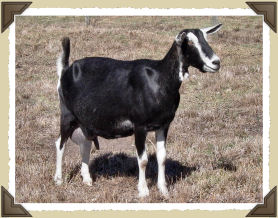The British Alpine Breed Standard
General
Appearance (style & quality): Tall, rangy and
graceful with smoothly blended body exhibiting pronounced
double dairy wedge shape, fine but not inclined to weakness.
Does feminine, bucks obviously masculine in appearance.
Head
(skull, eyes, mouth, nostrils): Head long with strong square
muzzle, facial line dished or straight, polled or neatly
disbudded. Eyes set well apart, full and bright. Ears erect
and pointing slightly forward.
Neck:
Blending smoothly into shoulders, with or without tassels.
Does long and fine. Bucks fine and strong, not coarse.
Backline:
Back strong, straight and horizontal or rising slightly to
the hips.
Forequarters: Withers fine and high, blending
firmly into shoulders. Chest full between the forelegs, deep
in bucks, fairly deep in does.
Body
(barrel): Abdomen well rounded, large, deep and wedge
shaped. Of proportionate length (to height).
Hindquarters: Gradual slope from hips to tail, good
width between hips and thurls. Rump long and flat, pin bones
wide and prominent.
Legs
(hooves): Long, strongly boned legs but not coarse or heavy.
Front legs straight and parallel from front and side. hind
legs straight and parallel viewed from rear, hocks slightly
bent when seen from the side, pasterns fairly short and
strong. Hooves sound and well shaped.
Udder:
Back attachment high and broad, fore attachment carried well
forward and blending smoothly to abdomen, not pendulous or
unduly divided, showing good capacity. Skin colour dark
(grey), pigmented in black and softly textured.
Testicles: Scrotum well attached, relatively even
and not divided or unduly pendulous, carrying two testes.
Teats: (Two)
Of adequate size for ease of milking, well attached and
distinct from the udder. Set well apart, pointing slightly
forward and down, not outward.
Rudimentary Teats: Two set wide apart slightly to
the fore and side of the scrotum, of good size but not
overdeveloped, unless the buck is milking.
Size
(height at withers): Does 32 inches (83 centimetres), Bucks
37 inches (95 centimetres).
Coat:
Short, fine and glossy, may have a fine grey undercoat.
Bucks may have a longer coat.
Colour:
Black with the following white Swiss markings : Facial
stripes from above eyes to muzzle and on muzzle, edges and
tips of ears, legs from knees and hocks down and inside of
legs to trunk, on rump and under the base of tail. Bucks :
facial stripes may fade in maturing bucks and (black coat)
may become grey on flanks with age.
Differing From The Ideal (found and recognised):
Indistinct facial marks. White hair around cheeks, forehead
at the base of or on tassel (s) or on throat in place of
tassels. Off white or cream markings instead of white.
Colour tending to greyness (salt & pepper) around base of
ears, throat or under neck. Less intense black. Other than
grey or black skinned udders. Horned. Nose with slightly
raised bridge. White ears. Uneven tassels, longer fringe
along backline and hindquarters.
Faults:
Rusty black coat colouring. Small white spots on body. Cow
hocks. Steeply sloping rump. Dropped pasterns. Roach back or
sway back. Size differing substantially from ideal. Uneven
gait. Poor feet. Splayed feet. Low set ears. Weak or narrow
chest. Shallow body. Lack of dairy quality. Fleshy,
pendulous or unduly divided udder. Pocket in udder. Teats :
small, thin, large, bulbous, ill defined or unbalanced. Lack
of milking capacity. Lack of masculinity in bucks. Divided,
uneven or unduly pendulous scrotum.
Disqualifications: Parrot mouth or obviously
undershot jaw. Wry face. White patches on barrel or other
than those specified above. Pink skinned udders. Double
teats, double orifices. Supernumerary teats. lntersex. Lack
of Swiss markings. White or cream belly. Pendulous ears.
Undescended testicles in bucks or one testicle only.
A Brief History of the British Alpine
The breed was developed in
Great Britain having its origins in a Sundgau goat,
Sedgemere Faith, found in the Paris Zoo in 1903. She had a
great influence on the breed but there were British Alpine
type goats around prior to her discovery. The type standard
was drawn up in the United Kingdom in 1919 after sufficient
true to type stock existed.
A separate section was created
in 1926 for the British Alpine in the British Goat Society
Herd Book. Two half sisters from the "Dhunan" herd of Mrs.
Laird, Scotland, arrived in Australia in 1958. They went to
Mrs. Evan's "Ashton" herd in Western Australia.
The next
year, two half brothers were sourced from New Zealand's "Ferncliffe"
herd of Mrs. Hopping. The sire of the bucks was Kewill
Kiltie and all four British Alpines had a common ancestor in
Kiltie's dam. A small gene pool to say the least, and
something which was to affect breeding capabilities in
Australia for decades. All four imports were accorded
Purebred status. The recessive gene for black in Saanens and
Toggenburgs in Australia enabled the breed to be
established.
Some breeders continued direct line breeding
whilst others also upgraded using the recessive gene
benefit. The last direct line doe of the 1958/59 imports was
born on 23/9/1968. The next direct breeding lines were from
more New Zealand importations in the 1970's from the "Ferncliffe"
herd. Stock from other New Zealand herds followed these
intermittently up until the late 1990's, some by embryo
transplant.
There is now no recognition of the difference of
sourcing of the Australian bred British Alpine in the
Australian Herd Book. Whereas previously direct lines and
upgraded lines had differing identifications now all
purebred stock carries the same letter-prefixes, either APM
for males or APF for females.
The breed is very active and
is well suited to free range situations, especially
commercial. They generally have a high quality milk and are
known for their extended lactations. Also, they have a high
inheritable trait for winter milking ability. Another
surprising attribute is their ability to cope with heat,
fitting them for the Australian climate.
|

